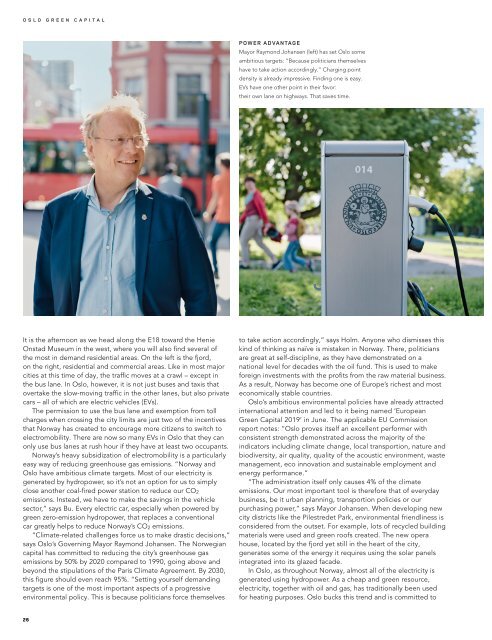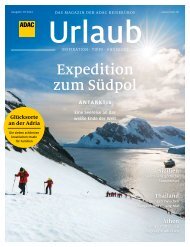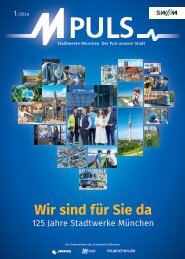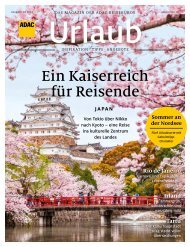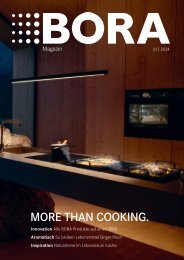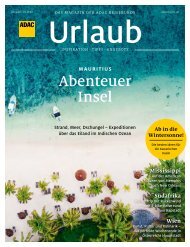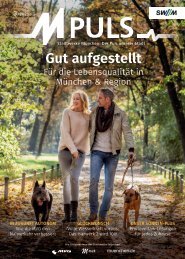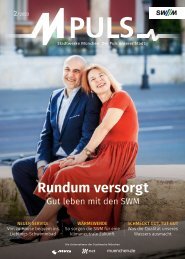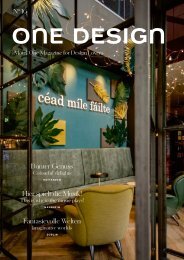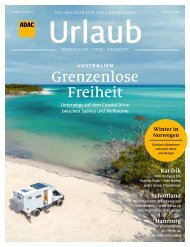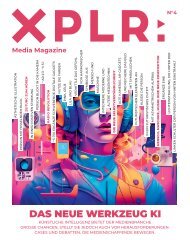ONELIFE #35 – American English
Land Rover steht für höchste Allradkompetenz, umfassenden Komfort und anspruchsvolle Technik. Diesem Geländewagen ist kein Weg zu weit und keine Aufgabe zu schwer – getreu dem Slogan „Above and Beyond“. ONELIFE vermittelt Land Rover-Kunden genau dieses Gefühl von Abenteuer und Freiheit.
Land Rover steht für höchste Allradkompetenz, umfassenden Komfort und anspruchsvolle Technik. Diesem Geländewagen ist kein Weg zu weit und keine Aufgabe zu schwer – getreu dem Slogan „Above and Beyond“. ONELIFE vermittelt Land Rover-Kunden genau dieses Gefühl von Abenteuer und Freiheit.
You also want an ePaper? Increase the reach of your titles
YUMPU automatically turns print PDFs into web optimized ePapers that Google loves.
OSLO GREEN CAPITAL<br />
POWER ADVANTAGE<br />
Mayor Raymond Johansen (left) has set Oslo some<br />
ambitious targets: “Because politicians themselves<br />
have to take action accordingly.” Charging point<br />
density is already impressive. Finding one is easy.<br />
EVs have one other point in their favor:<br />
their own lane on highways. That saves time.<br />
It is the afternoon as we head along the E18 toward the Henie<br />
Onstad Museum in the west, where you will also find several of<br />
the most in demand residential areas. On the left is the fjord,<br />
on the right, residential and commercial areas. Like in most major<br />
cities at this time of day, the traffic moves at a crawl <strong>–</strong> except in<br />
the bus lane. In Oslo, however, it is not just buses and taxis that<br />
overtake the slow-moving traffic in the other lanes, but also private<br />
cars <strong>–</strong> all of which are electric vehicles (EVs).<br />
The permission to use the bus lane and exemption from toll<br />
charges when crossing the city limits are just two of the incentives<br />
that Norway has created to encourage more citizens to switch to<br />
electromobility. There are now so many EVs in Oslo that they can<br />
only use bus lanes at rush hour if they have at least two occupants.<br />
Norway’s heavy subsidization of electromobility is a particularly<br />
easy way of reducing greenhouse gas emissions. “Norway and<br />
Oslo have ambitious climate targets. Most of our electricity is<br />
generated by hydropower, so it’s not an option for us to simply<br />
close another coal-fired power station to reduce our CO 2<br />
emissions. Instead, we have to make the savings in the vehicle<br />
sector,” says Bu. Every electric car, especially when powered by<br />
green zero-emission hydropower, that replaces a conventional<br />
car greatly helps to reduce Norway’s CO 2 emissions.<br />
“Climate-related challenges force us to make drastic decisions,”<br />
says Oslo’s Governing Mayor Raymond Johansen. The Norwegian<br />
capital has committed to reducing the city’s greenhouse gas<br />
emissions by 50% by 2020 compared to 1990, going above and<br />
beyond the stipulations of the Paris Climate Agreement. By 2030,<br />
this figure should even reach 95%. “Setting yourself demanding<br />
targets is one of the most important aspects of a progressive<br />
environmental policy. This is because politicians force themselves<br />
to take action accordingly,” says Holm. Anyone who dismisses this<br />
kind of thinking as naïve is mistaken in Norway. There, politicians<br />
are great at self-discipline, as they have demonstrated on a<br />
national level for decades with the oil fund. This is used to make<br />
foreign investments with the profits from the raw material business.<br />
As a result, Norway has become one of Europe’s richest and most<br />
economically stable countries.<br />
Oslo’s ambitious environmental policies have already attracted<br />
international attention and led to it being named ‘European<br />
Green Capital 2019’ in June. The applicable EU Commission<br />
report notes: “Oslo proves itself an excellent performer with<br />
consistent strength demonstrated across the majority of the<br />
indicators including climate change, local transportion, nature and<br />
biodiversity, air quality, quality of the acoustic environment, waste<br />
management, eco innovation and sustainable employment and<br />
energy performance.”<br />
“The administration itself only causes 4% of the climate<br />
emissions. Our most important tool is therefore that of everyday<br />
business, be it urban planning, transportion policies or our<br />
purchasing power,” says Mayor Johansen. When developing new<br />
city districts like the Pilestredet Park, environmental friendliness is<br />
considered from the outset. For example, lots of recycled building<br />
materials were used and green roofs created. The new opera<br />
house, located by the fjord yet still in the heart of the city,<br />
generates some of the energy it requires using the solar panels<br />
integrated into its glazed facade.<br />
In Oslo, as throughout Norway, almost all of the electricity is<br />
generated using hydropower. As a cheap and green resource,<br />
electricity, together with oil and gas, has traditionally been used<br />
for heating purposes. Oslo bucks this trend and is committed to<br />
26


